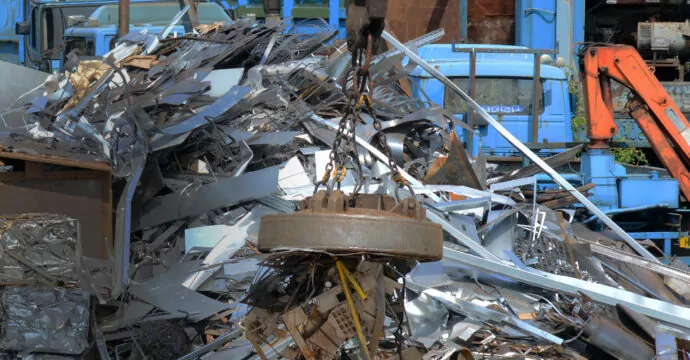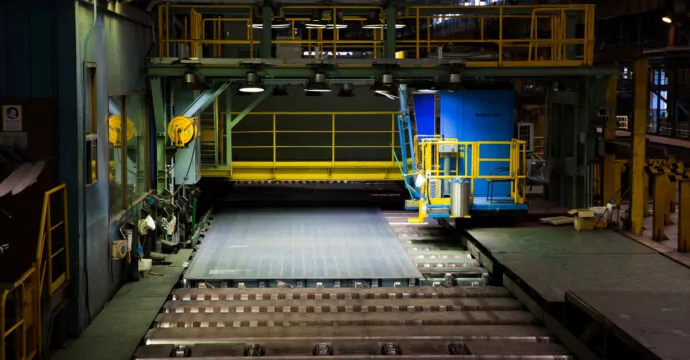News
2025/ 07 / 10
Scrap and the Steel Industry
Scrap is an important component of the entire steel industry, and its importance in reducing CO2 emissions, saving resources and driving the industry’s economic development is gradually increasing. Despite this, the problems existing in various scrap processing links pose challenges to steel companies.
As governments around the world strive to meet their own net zero emissions commitments and introduce stricter recycling regulations, the pressure on the steel industry to meet these challenges will only increase.

As described in the journal published by the World Steel Association, steel is one of the most widely used materials in the world. From buildings and bridges to cars and household appliances, steel is everywhere. But what happens when steel products reach the end of their useful life in all these applications? In fact, reaching the end of the useful life does not mean the end of the steel life cycle. Because steel can be recycled 100% infinitely without degrading its quality. When scrap steel reaches the end of its useful life, it is melted down and new steel can be produced.
This involves several stages:
Recycling
A large amount of scrap steel currently used in the steelmaking process is recycled before it enters the trading market. This scrap steel is also called new scrap steel. It is the scrap generated during large-scale industrial manufacturing processes, such as the production of household appliances, cars and electronic products. This type of scrap is collected in one place, so it is less contaminated by other materials, making it more valuable and widely and fully utilized.
However, when consumers think of scrap, they are most likely to think of steel that has reached the end of its useful life (or depreciated scrap). This is because household items or other products are sent to specialized recycling stations after their useful life ends. This type of scrap also includes scrap collected from unfamiliar sources, such as dismantled ships and old industrial facilities. The wide variety of scrap sources and potential contaminants makes it challenging to collect depreciated scrap in an environmentally friendly and safe manner and transport it to steel mills.
Sorting
Scrap needs to be sorted and separated according to the type and quality of the product. Steel is made from a mixture of various alloys and materials (such as carbon, chromium, manganese, nickel, etc.), so the grade of steel to be produced needs to be matched with scrap with the corresponding properties. It is not just the type of alloys contained in the scrap that complicates the production process, but also the amount of each alloy. Different levels of carbon in the steel can significantly affect the hardness, strength or weldability of the final product, so these factors need to be taken into account.
Of course, the scrap mix also contains many completely unwanted elements, many of which (such as copper) are difficult to separate from the iron contained in the steel. There is a great deal of variation between the different sorting methods, ranging from using magnets to separate the scrap from the non-ferrous metals, to using specially developed high-precision sorting equipment, or equipment that is developed and patented by the recycling company or steel company itself. The initial cost and maintenance requirements of the equipment can be considerable, so companies are always looking for ways to improve efficiency.
In addition, the management of unwanted elements in a safe and environmentally friendly manner, storage and location issues also have corresponding costs and risks.

Shredding
After sorting, the large pieces of scrap are fed into industrial shredders to cut them into smaller pieces for transportation and further processing.
Melting and refining
The shredded scrap is melted in steelmaking furnaces, where it is heated to over 1600°C (2900°F) to become molten steel. The molten steel is then refined by adding fluxes such as lime to remove any remaining impurities.
Casting and rolling
The refined molten steel is poured into casting equipment, cooled and rolled into new steel products such as plates, bars or profiles, which can then be used as is or further processed into other products.
Scrap is most commonly melted in electric furnaces, where 100% scrap can be added, although the blast furnace-converter process can also add up to 30% scrap.

Shredding
After sorting, the large pieces of scrap are fed into industrial shredders to cut them into smaller pieces for transportation and further processing.
Melting and refining
The shredded scrap is melted in steelmaking furnaces, where it is heated to over 1600°C (2900°F) to become molten steel. The molten steel is then refined by adding fluxes such as lime to remove any remaining impurities.
Casting and rolling
The refined molten steel is poured into casting equipment, cooled and rolled into new steel products such as plates, bars or profiles, which can then be used as is or further processed into other products.
Scrap is most commonly melted in electric furnaces, where 100% scrap can be added, although the blast furnace-converter process can also add up to 30% scrap.
Carbon emissions
As shown in the Sustainability Indicators report, the average CO2 emissions from the electric furnace process are significantly lower than those from the more established blast furnace process. The energy requirements are also much lower.
The worldsteel Association estimates that the world consumes around 650 million tonnes of scrap steel each year, which would save around 975 million tonnes of CO2 emissions each year and significantly reduce the use of other natural resources such as iron ore, coal and limestone, and the associated production emissions.
This often leads to the question: why can’t the entire steel industry produce in this way? Currently, there is a shortage of scrap steel to meet the demand for steel production. Given the average lifespan of steel products, which range from a few weeks for steel packaging materials to centuries for buildings and infrastructure, we estimate the average lifespan of steel products to be 40 years, which means there is a significant delay between the production of steel and the emergence of recyclable scrap.
Although we have made significant progress in the scrap sector in recent years, there are challenges in producing certain types of steel from scrap processes.
We estimate that the global supply of depreciated scrap will reach about 900 million tons in 2050. This is mainly due to the steel consumed by China during its rapid industrialization in the first decade of the 21st century, which will become depreciated scrap. However, with current steel demand of 1.75 billion tons, a mere 900 million tons of supply is far from enough.
Contact Us
Address
High-tech Industrial Development Zone, Zhengzhou City, Henan Province, China.
jean@ji-steel.com
Phone
+86 188 3804 2177
Products
- Continuous Casting
- ● Copper Mould Tube
- ● Mould Assembly
- ● Ladle And Tundish Nozzle
- Steel Melting
- ● Graphite Electrode
- ● CPC/GPC
- ● Continuous Casting Protecting Slag
- ● Furnace Lining Vibrator
- Rolling Mill Equipment
- ● Steel Roll
- ● Tungsten Carbide Roll Ring
- ● Rolling Mill Guides
- ● Roller Table
Contact
- jean@ji-steel.com
- +86 371 6781 0168
- +86 188 3804 2177
- +86 188 3804 2177
- www.ji-steel.com
- High-tech Industrial Development Zone, Zhengzhou City, Henan Province, China.